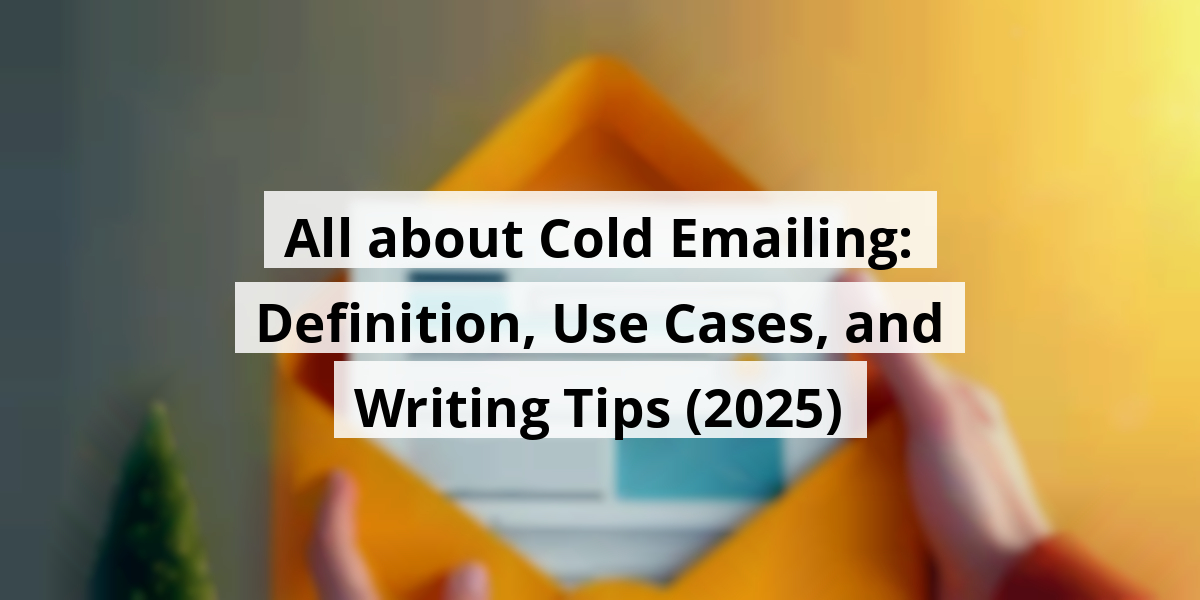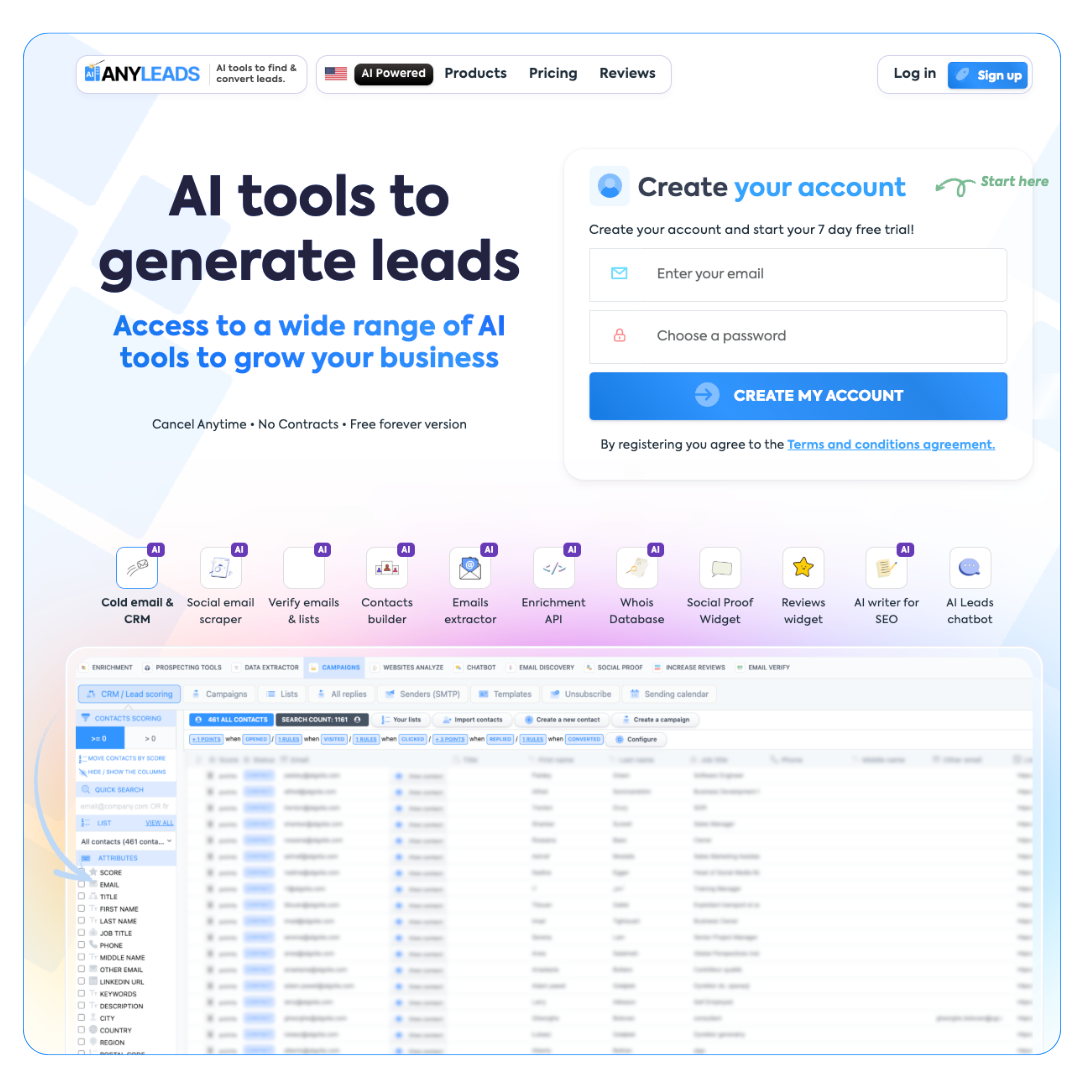 LIMITED SPOTS
All plans are 30% OFF for the first month! with the code WELCOME303
LIMITED SPOTS
All plans are 30% OFF for the first month! with the code WELCOME303

 LIMITED SPOTS
All plans are 30% OFF for the first month! with the code WELCOME303
LIMITED SPOTS
All plans are 30% OFF for the first month! with the code WELCOME303


Now we are going to talk about the intriguing world of cold emailing and how it can be a fantastic tool for connecting with potential leads.
A cold email is essentially a first-time email that lands in someone’s inbox without any previous interaction.
Think of it as your digital handshake—possibly less awkward but still a tad nerve-wracking. If done right, cold emailing is anything but spam. It’s more like throwing a well-aimed paper airplane into a classroom full of curious kids rather than a random flyer at a bus stop. When executed thoughtfully, a cold email transforms from mere words on a screen into a targeted message, igniting interest in sales, recruiting, or networking.
Yet, let's make one thing clear: it's not about firing off emails to every Tom, Dick, and Harry on your contact list. Only those who know their audience truly succeed. Kind of like cooking without a recipe—some end up whipping up a delicious masterpiece, while others… well, let’s just say burned toast is an unfortunate reality.
What does this mean for us? It means we've done our homework. We’ve peeled back the layers on who we're reaching out to, understanding what they need, and curating our message just for them. Hitting them up at the perfect time can make all the difference. Nobody wants to hear about your company’s revolutionary rubber band—especially if it's not relevant to them!
The ultimate objective of a cold email isn't merely to be read. It’s about sparking a conversation—a friendly tête-à-tête over the digital ether! We're not aiming to sell a life insurance policy right off the bat; rather, we’re seeking to open the door and see if there's potential for a more meaningful relationship. Think of it as asking, "How’s it going?" rather than "Want to buy my stuff?"
Despite several myths surrounding cold emailing, it remains a cost-effective and scalable method to boost your business revenue.
Here’s a fun fact: A successful cold email can brag about a whopping 70% conversion rate. Imagine knocking on someone’s door, and they not only answer but invite you in for a chat. That's the magic we’re talking about here.
Here are a few essential elements that make cold emails not only bearable but compelling:
Fear not! We’ll discuss these elements in more detail as we go along—it's like a never-ending pizza party of information!
Now we are going to talk about the differences between cold emails and email marketing. Buckle up, because this ride is going to get interesting!


So, imagine you’re at a party with that one friend who can’t take a hint. You know, the type who approaches random strangers with a sales pitch. That’s essentially the vibe of a cold email. It’s like a handshake between two people who’ve never met. The goal? To spark a conversation about business or networking.
These emails are crafted for specific individuals—like a conglomerate of wild cats looking for their turf. We tailor our messages to resonate with what makes each recipient tick. It’s about striking a chord, right? If done well, we can gauge success through engagement and responses. High-five!
On the flip side, we have email marketing, which feels more like sending out invitations to a brunch we’ve already had with friends. This time, the recipients are folks who have opted in, eager to receive our updates, promotions, and good ol’ news about our adventures. Think about those delightful newsletters—from brand offers to quirky stories—we casually read while sipping coffee.
So, why do we lean towards cold emails when it comes to outreach? Well, much like the early morning joggers trying to lose that extra holiday cookie, it’s about initiation. We seize the moment to present our business—reeling in the prospect like a fish on a hook. But the catch? The follow-up is crucial!
Meanwhile, in our marketing escapades, we strengthen bonds over time with our email lists. This builds trust; we nurture existing relationships like gardeners tending to their blossoming rose bushes. Who doesn’t enjoy a little sunshine in their inbox, right?
In a way, cold emails can feel like skydiving, while email marketing is like jogging through the park—one is about adrenaline and the thrill of the new, while the other is about comfort and familiarity.
In short, whether you're seeking to break the ice through cold emails or charming your loyal followers with email marketing, knowing when to use each can set us up for success. So keep those emails flowing, but remember—communication is a two-way street! Let’s keep it engaging and fun, just like a ping pong match never gets old!
Now we are going to talk about the legality of cold emailing, which is quite the hot topic, especially in the world of marketing these days. It seems everyone has an opinion, and it can feel like walking a tightrope – one bad email, and you might get booted off the internet! Let’s break it down.

Sure thing! Cold emailing is perfectly fine under the law, but don’t start throwing confetti just yet. There are laws, like GDPR and CAN-SPAM Act, that put a few speed bumps in your email marketing highway. It’s not about sending unsolicited emails; it’s about being respectful and smart about it.
So, what does it mean to stay on the right side of the email gods? Well, it comes down to respecting people's time and inboxes. Remember that time Uncle Joe wouldn't stop talking about his stamp collection? We all love Uncle Joe, but there’s a limit!
Let’s not just hawk products; think of it as sparking a conversation. Who knows? That chat might lead to new friendships—or, you know, business deals!
Here are a few key points to ensure that our cold emailing is both ethical and legal:
If we ignore the law, the consequences can be hefty. Fines and penalties can sneak up like a cat ready to pounce on a mouse. So let’s dot our i's and cross our t's to keep our cold emailing practices as squeaky clean as a new pair of shoes!
| Tip | Details |
|---|---|
| Offer Opt-Out | Include a clear way for recipients to unsubscribe. |
| Prompt Action | As soon as someone opts out, remove them right away! |
| Clear Sender Info | Accurately display your sender's information. |
| No False Claims | Your subject line should match the email content. |
| List Hygiene | Regularly clean your email list for better results. |
Now we are going to talk about the perks of using cold emailing, and believe us, there’s a lot to unpack here!
Cold emailing, when done right, isn’t just sending digital messages into the void; it’s a powerful tool that can help us hit our business goals and increase our revenue.
Let’s share our top reasons why we think cold emailing can be a real winner:
Imagine being able to reach out to potential clients without breaking the bank. Cold emailing is like finding a five-dollar bill in an old coat pocket—surprisingly beneficial! It doesn’t demand much cash upfront, making it perfect for small businesses and startups alike.
Think about it—how many times have we put off a meeting, and it turned into an epic saga? Cold emails cut through the red tape and put us in direct contact with the decision-makers. It's like jumping the line at a coffee shop; we get straight to the good stuff!
This isn’t a one-size-fits-all approach. With cold emails, we have the liberty to personalize our messages extensively. Have you ever received an email that felt like it was written just for you? It’s that special feeling that gets us a response!
With cold emailing, we’ve got the data at our fingertips. We can track metrics like open rates and conversions faster than a cat can knock something off the table. This information helps us sharpen our strategies—let’s call it the detective work of marketing!
Time is money, right? Sending out cold emails is like whipping up instant noodles—quick and rewarding. We can potentially reach loads of prospects in a flash, which is especially helpful in beating competitors to the punch.
In summary, cold emailing can be an incredible tool in our marketing toolkit. From offering cost savings to delivering fast, trackable results, it’s worth considering for anyone looking to expand their reach. After all, who doesn’t love a little extra ROI in their lives?
Now we are going to talk about crafting a cold email campaign that doesn't just hit the inbox but hits a home run! Think of it as writing a love letter, but instead of wooing a crush, we're wooing potential customers. Here’s how we can make our emails sing without sounding like a robot.


Getting your cold email strategies rolling takes a little finesse. But fear not! Here’s a fun compilation of essential steps to keep your campaign as smooth as butter on hot toast.
Creating an ideal customer profile is like crafting a recipe. You want the right mix of ingredients for success! Think about who truly benefits from what you offer. Does your product fit a small tech startup in Silicon Valley or a cozy bookstore in a rural town? Get specific! It’s key!
Once you've cooked up those profiles, put them into tiers. Trust us; it saves loads of headaches later. Focus your energy where it counts the most. Who wouldn't want to spend more time schmoozing with those top-tier personas that can churn out caixa preta - oops, sorry, we meant revenue!
(Pssst! A little hint: make sure your profiles work like they should. If they don't yield better results than random outreach, it’s time to hit the reset button).
Alright, we’ve got our perfect match in mind. Now, it’s like setting up for a blind date. You wouldn’t just invite random folks off the street, right? Focus on targeting your profiles.
The good news? There are myriad ways to find those potential buyers.
LinkedIn is like an all-you-can-eat buffet for salespeople. You can use its search filters to find your dream client. Seriously, it feels like shopping for leads!
Pro Tip: There’s a nifty little extension out there (we can’t help but mention it) that can collect associated contacts directly from LinkedIn. It’s like having a digital assistant—minus the coffee runs!
Lead databases are pure gold. They’ve got all that juicy data just waiting for you to munch on. You can filter based on industry, company size, and more. It’s like tailoring your smoothie to fit your health goals!
Next up? You want those golden nuggets of communication—the verified email addresses. Think of them as VIP passes to engage your ideal buyers.
Using email verification tools can save a lot of time—and a lot of embarrassing bounce-back situations! After all, you wouldn't want to send a romantic text to the wrong number, would you?
Timing is everything. Imagine showing up to a party two hours late—awkward, right? As we reach out, we need to identify the signs that indicate when leads are most receptive. Here are some clear triggers:
We’ve got to be situational! No one wants to be that overzealous friend, sliding into DMs at the wrong moment.
Before hitting the send button, make sure your email account is primed and ready to go. It's like preparing for a big date—you wouldn’t show up in sweats!
Ensure you have proper settings to avoid the spam folder—that dreaded pit of lost emails. Yes, it's worse than being left on "Read"!
Let’s face it: Nobody wants to read a sob story about how great your product is. Instead, focus on their needs! Get creative with your subject line. It’s the first line of your narrative, and you want readers curious like a cat chasing a laser dot.
Don’t be that one-dimensional person always talking about themselves. Instead, sprinkle in details that show you’ve done your homework!
Remember, it’s about igniting a conversation—not just firing off a sales pitch. Make them feel that it’s about them. Build a relationship, and the sales will follow.
If they don't reply, worry not! Following up is an art—as delicate as a soufflé! Understanding your prospects' preference for communication can increase engagement significantly.
Here’s the kicker: don’t spam! A gentle nudge here and there can work wonders. Think of it like watering a plant; it needs care, but too much can drown it.
Lastly, always keep an eye on your metrics. The numbers tell a story; listen up! Use A/B testing to figure out what clicks. Adjust your approach like a maestro conducts an orchestra—each note counts!
Ultimately, the path to successful cold emailing is all about how you choose to connect with your audience. Let’s go make some magic happen!
Now we are going to explore how cold emailing can open doors for various sectors, making connections that could benefit everyone involved.
Cold emailing isn’t just for those desperate salespeople trying to peddle their wares. Oh no, this tool is like a Swiss Army knife, useful for a variety of roles. Just like my attempts to bake a soufflé inevitably lead to delightful kitchen chaos, the unpredictable nature of cold emails can lead to some surprisingly fruitful conversations!
So, how does this look across different fields? Let’s break it down:
[ ] Spotting Top Tier Leads
Use cold emails to seek out those dream clients who fit your perfect customer profile. It’s like online dating, but for businesses—minus the awkward first date!
[ ] Arranging Meetings or Demos
Why not suggest a coffee meeting, albeit virtually, to showcase your amazing product? It’s like asking for a second date when the first one went well.
Open up new business avenues, surpass those sales targets, and watch your revenue climb like my teenager on a sugar high during Halloween.
[ ] Launch Announcements
Getting the word out about a new product? Offer exclusive discounts or sneak peeks. It’s a little like waving a shiny new toy—everyone loves shiny things!
[ ] Event Promotion
Share event deets and what attendees can gain. Think about it as the modern-day equivalent of handing out flyers, minus the paper cuts.
[ ] Requesting Customer Feedback
Offer discounts for insights. Who doesn’t love a good deal? It’s like asking for a favor, but you’ve got a sweetener thrown in!
[ ] Lead Generation
Send targeted emails that tackle customers’ pain points. It’s like being the doctor with the perfect remedy!
[ ] Building Partnerships
Connect with businesses or influencers in your space. Like a teenage friendship bracelet, it shows you’re serious about teaming up!
[ ] Cross-Selling & Upselling
Keep tabs on what your clients are buying and suggest complementary products. Just think of it as a gentle nudge toward happiness (and increased sales)!
[ ] Creating a Talent Pipeline
Build relationships with future candidates. It’s like planting seeds in your garden—you’ll reap the benefits when you need them!
[ ] Networking with Professionals
Reach out to industry stars. It’s like trying to befriend the cool kids; sometimes it pays off in ways you didn’t see coming.
[ ] Promoting Your Employer’s Brand
Show potential recruits the wonderful culture of your organization. Sell the dream and watch those talent applications roll in like butter on hot toast!
Now we are going to talk about the benefits of investing in cold email software. This is quite an exciting topic!

By now, it's clear that cold emailing is becoming the go-to strategy for businesses. And trust us, investing in cold email software is like giving your outreach a shot of espresso – it perks everything up!
Picture this: you're swamped with leads, emails flying everywhere, and your to-do list looks like a novel. Ah, the sweet chaos of it all! That's where cold email software steps in as your trusty sidekick. It's like having a digital butler who not only organizes your email but also helps you track everything without getting lost in the shuffle.
Whether you're an SDR, growth marketer, recruiter, or founder, let’s face it – this software can be your best friend in expanding your business through cold outreach.
To save us all from the headache of guesswork, check out our comparison of the best cold email software options currently available:
| Software Name | Key Features | Pricing |
|---|---|---|
| Mailshake | Automation, A/B Testing | From $59/month |
| Woodpecker | Follow-ups, Personalization | From $40/month |
| Reply.io | CRM Integration, Analytics | From $70/month |
| Sendinblue | Email Marketing, SMS | From $25/month |
| ActiveCampaign | Customer Experience Automation | From $15/month |
Having the right tool means you can skip the hassle and focus on what really counts – connecting with those potential clients.
And with this software, it’s like being handed a roadmap in a strange city – you know exactly where to next!
Plus, let’s not forget about the time savings! If you’re anything like us, you have enough on your plate without adding “email oversight” to your résumé. These tools handle the nitty-gritty, letting us breathe a little easier.
So, the bottom line? Investing in cold email software is pretty much the best decision you can make for scaling your outreach efforts. Let’s give it the ol' college try and watch our email strategy thrive!
Now we are going to talk about how to kick off cold emailing and leverage some nifty tools to make it less of a chore!


Cold emailing can be like fishing; sometimes you catch a big one, and other times... well, it's just a boot. But with the right approach, it’s a sure-fire way to snag great opportunities!
Who hasn’t stared blankly at their screen, coffee in one hand, fingers hovering over the keyboard, wondering how to get started? Fear not! Here’s how we can streamline this process with a shining beacon of hope—an email tool.
Ever used a tool that feels like it was created by wizards? We’ve spotted one that’s genuinely impressive! This tool allows us to find, connect with, and persuade great prospects without the hassle. Ready to jump in? Let’s roll!
Follow these steps to get your cold email campaigns up and running:
It feels like we’re whipping up a recipe, doesn’t it? But here’s where the cooking gets interesting.
Speaking of tools, it’s vital to know your audience! Anyone who’s ever lost a nice cold email in the sea of spam knows how crucial it is to understand which Mailing Service Providers (MSPs) we’re dealing with. You wouldn’t invite a fish to a picnic, right?
We've witnessed folks flounder when they pivot their Ideal Customer Profiles (ICPs). One missed setup, and they’re stuck sending emails to the Bermuda Triangle of inboxes. Take note of whether your prospects are cruising on Gmail, Outlook, or their own island of obscure email services!
In conclusion, let’s keep our eyes peeled! Cold emailing is a mix of art and strategy, with just the right touch of wit and humor. By harnessing these steps and tools, we can transform tedious email tasks into a fun—and effective—experience!
Now we are going to discuss some common queries about cold emails that can help us refine our outreach game. Buckle up, my friends, because this is going to be as enlightening as a Saturday morning coffee chat!
Experts have found that the magical length for a cold email is around 120 words. Crazy, right? This sweet spot often yields a booking rate of around 50%. However, if you stretch your email to about 75 to 125 words, you may see a better reply rate by about 5 to 15%. Think of it like Goldilocks—find what’s just right!
After sifting through countless subject lines, we’ve discovered that the best cold email subject ranges from 1 to 8 words. Believe it or not, a single-word subject line can grab attention if it delivers value. Talk about a word workout!
Our latest findings suggest that a solid opener should be between 4 to 12 words. Aim for something engaging that tells them why they should care—after all, nobody wants to read a snooze-fest!
Absolutely! Including images can give your cold emails a charming touch. In fact, campaigns that use visuals can achieve up to a 42% higher click-through rate. Just imagine how seeing a cute cat pic could make someone say, “Sign me up!”
Relax; no worries here. Our analysis showed no significant differences in deliverability rates between emails with images and those without. So go ahead, add that cute cat—your emails won’t end up in spam heaven!
While they can be fun, studies showed that emails with emojis tend to receive 13% fewer replies. Emojis can be like hot sauce; a dash can spice things up, but too much leaves a bitter taste. Use wisely!
According to our analysis, Mondays are the champions for sending cold emails. Of course, it’s not just about when you send but when those lovely will respond. Some jump on your email within hours, while others need a little nudge.
Timing is everything, folks! Hitting “send” between 8 and 10 AM means your email bursts into inboxes fresh and bright. Picture it: your message is like the first piece of toast in the morning—there’s nothing quite like it!
Most providers suggest that keeping it around 100 per day is best to avoid landing in the ol’ spam folder. And remember, breaking the limit can have your outreach efforts flagged. Don’t you love a good email drama?
Following up 4 to 9 times can boost your chances of a response. But be careful—too many follow-ups, and you risk getting booted into the spam abyss. Keep it classy, folks!
Aiming for an open rate above 50% is great. If you find your rate creeping lower, consider starting fresh with new tactics—like a wardrobe cleanse for emails!
In 2023, a reply rate in the range of 5-8% is average, but anything closer to 10-15% feels like winning the jackpot. If you’re snagging 15-30%, well, you might want to buy a lottery ticket while you’re at it!
When it comes to cold emailing, there are pitfalls we must dodge. Here’s a quick summary of the usual suspects:
For a deeper dive into these cold email misfires, check out more detailed examples and solutions here. Let’s keep those cold emails warm and welcoming!

